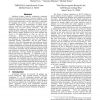Free Online Productivity Tools
i2Speak
i2Symbol
i2OCR
iTex2Img
iWeb2Print
iWeb2Shot
i2Type
iPdf2Split
iPdf2Merge
i2Bopomofo
i2Arabic
i2Style
i2Image
i2PDF
iLatex2Rtf
Sci2ools
ISCA
1998
IEEE
1998
IEEE
Multi-Level Texture Caching for 3D Graphics Hardware
Traditional graphics hardware architectures implement what we call the push architecture for texture mapping. Local memory is dedicated to the accelerator for fast local retrieval of texture during rasterization, and the application is responsible for managing this memory. The push architecture has a bandwidth advantage, but disadvantages of limited texture capacity, escalation of accelerator memory requirements (and therefore cost), and poor memory utilization. The push architecture also requires the programmer to solve the binpacking problem of managing accelerator memory each frame. More recently graphics hardware on PC-class machines has moved to an implementation of what we call the pull architecture. Texture is stored in system memory and downloaded by the accelerator as needed. The pull architecture has advantages of texture capacity, stems the escalation of accelerator memory requirements, and has good memory utilization. It also frees the programmer from accelerator texture m...
Related Content
| Added | 05 Aug 2010 |
| Updated | 05 Aug 2010 |
| Type | Conference |
| Year | 1998 |
| Where | ISCA |
| Authors | Michael Cox, Narendra Bhandri, Michael Shantz |
Comments (0)

